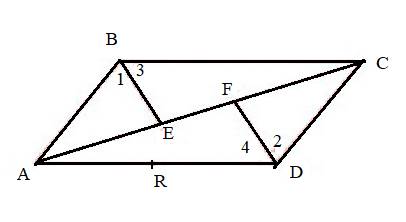
Concept explainers
a
The possible names of the line containing the points.
a
Answer to Problem 1RP
Possible names are
Explanation of Solution
Given information:
A quadrilateral ABCD

So, the possible name of line segment can be
b.
b.
Answer to Problem 1RP
The side containing the angle ∠ABC is AB and BC.
Explanation of Solution
Given information:
A quadrilateral ABCD

The side containing the angle ∠ABC is AB and BC.
c.
c.
Answer to Problem 1RP
The common side of ∠2 and ∠4 is DF
Explanation of Solution
Given information:
A quadrilateral ABCD
The common side of ∠2 and ∠4 is DF

d.
d.
Answer to Problem 1RP
The horizontal ray containing the end point C is BC.
Explanation of Solution
Given information:
A quadrilateral ABCD

A ray is defined as a part of a line with a start point but no end point.
The horizontal ray containing the end point C is BC.
e.
e.
Answer to Problem 1RP
∠BAD

∠2

∠ABC

Explanation of Solution
Given information:
A quadrilateral ABCD
f.
To find whether the two angle are same.
f.
Answer to Problem 1RP
Both the angles are same.
Explanation of Solution
Given information:
A quadrilateral ABCD

The angle FCD and angle DCE represent the same angle as point E and F are on the same line segment.
g.
g.
Answer to Problem 1RP
The angle B is the angle containing the side AB and BC.
Explanation of Solution
Given information:
A quadrilateral ABCD
The side containing the angle ∠ABC is AB and BC.

h.
h.
Answer to Problem 1RP
Explanation of Solution
Given information:
A quadrilateral ABCD
Ray FC is on ray EC so their union is EC.
i.
i.
Answer to Problem 1RP
Explanation of Solution
Given information:
A quadrilateral ABCD
Common part in ray EC and FA is segment EF
j.
j.
Answer to Problem 1RP
Explanation of Solution
Given information:
A quadrilateral ABCD
Ray BA and ray BE together forms ∠ABE
k.
k.
Answer to Problem 1RP
Explanation of Solution
Given information:
A quadrilateral ABCD
Line AC and DR intersect at point A.
l.
l.
Answer to Problem 1RP
Explanation of Solution
Given information:
A quadrilateral ABCD
Angle AFD and line segment CE both intersect to give line segment EF.
Want to see more full solutions like this?
Chapter 1 Solutions
Geometry For Enjoyment And Challenge
Additional Math Textbook Solutions
Elementary Statistics
Algebra and Trigonometry (6th Edition)
Calculus: Early Transcendentals (2nd Edition)
Pre-Algebra Student Edition
Elementary Statistics: Picturing the World (7th Edition)
College Algebra with Modeling & Visualization (5th Edition)
- 39 Two sides of one triangle are congruent to two sides of a second triangle, and the included angles are supplementary. The area of one triangle is 41. Can the area of the second triangle be found?arrow_forwardA parallelogram with an area of 211.41 m^2 hast a base Thatcher measures 24.3m. Find ist height.arrow_forwardBH is tangent to circle A and DF is a diameter. I don't know where to go from here. May you help please?arrow_forward
 Elementary Geometry For College Students, 7eGeometryISBN:9781337614085Author:Alexander, Daniel C.; Koeberlein, Geralyn M.Publisher:Cengage,
Elementary Geometry For College Students, 7eGeometryISBN:9781337614085Author:Alexander, Daniel C.; Koeberlein, Geralyn M.Publisher:Cengage, Elementary Geometry for College StudentsGeometryISBN:9781285195698Author:Daniel C. Alexander, Geralyn M. KoeberleinPublisher:Cengage Learning
Elementary Geometry for College StudentsGeometryISBN:9781285195698Author:Daniel C. Alexander, Geralyn M. KoeberleinPublisher:Cengage Learning

